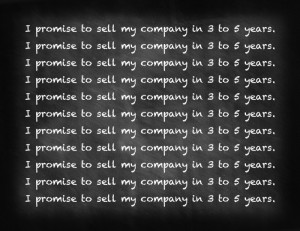A post this summer from Jason Mendelson of the Foundry Group really caught my eye. It is about the explicit “VC Bargain” that an entrepreneur makes when taking an investment from a venture capital firm. Basically, the VC fund will need the founders to commit to a liquidity event (exit of some sort) for their company, often within 3-5 years after the investment. This is mandatory for the fund because the fund has an agreement, in turn, with its investors to return capital to them within ten years. Sometimes, VCs and private equity investors prefer not to advertise this element of their business and state that they “are in it for the long-term”. I respect Jason for being up-front about the VC bargain.
As I have written before, this VC Bargain can be an ideal set-up for certain companies. Usually, this means the prototypical Silicon Valley company where everyone from the VCs, to the founders, to the employees are aligned around super fast growth and an exit event. That can be all good. It’s been an amazingly powerful and successful model for many decades.
VC Bargain — Not for Everyone — Different Strokes for Different Folks
Because of the success of that model, I believe that the model has been applied to all sorts of companies for which it is not well suited. In fact, most companies are not well served by the traditional venture capital or private equity model. Only 16% of the Inc 500 fast-growing companies have investments from venture capital firms, according to work by Paul Kedrosky for the Kauffman Foundation.
I recommend that companies and founders put as much thought into the motivations, restrictions, formulas for value creation, status of the VC firm, portion of the VC fund from which the VC is investing currently, and these timings of the investment firm from whom they take investments as they would for key operations hires or key operating vendors. Often, I find that founders may not appreciate the vast differences between VC firms. The structure and strategy of the VC firm will drive key decisions and inputs into the strategy of an operating company — more than just what’s best for the company. Sometimes it doesn’t make sense for the founder and company to bet everything on trying for a home run — which may also result in a strike-out with the founder’s most precious and valuable asset.
Your company is unique, and you should find the capital source that is best aligned with the uniqueness of your company.
I have formed my investment fund, Greybull Stewardship, with this in mind. I built the structure of my fund to provide maximum flexibility to the founder and for the company. There is no time horizon in which an exit is required because my fund exists in perpetuity. There are no requirements for growth rate or type of strategy. The sole consideration is what is the best strategy for value creation for the founder and the company — which also means that we investors will do well also.
Posts Related to VC Bargain
- Built to Last or Built to Flip? [masonmyers.com — June 19, 2013]
- Investment Strategy & Structure is the #1 Thing Founders and CEO’s Should Watch in Raising Capital [masonmyers.com — March 24, 2013]
- Founder & VC Misalignment More Often Than Thought [masonmyers.com — January 10, 2013]
- You Are What You Eat (Or Where You Get Your Investment) [masonmyers.com — November 26, 2012]
- Honey, I Shrunk the Definition of “Long-Term Investing” [masonmyers.com — September 26, 2012]


 I am an investor at Greybull Stewardship, an
I am an investor at Greybull Stewardship, an 
 Sign Up
Sign Up RSS Feed
RSS Feed
By Old School Myths About the Ideal Time for Raising Capital (of the Right Type) - Mason Myers Blog October 6, 2013 - 2:37 pm
[…] have written often about trying to find the right source of capital in these blog posts: VC Bargain: capital in exchange for the ‘duty’ to sell your company; Flippers and holders; Strategy and Structure; You are what you eat (or where you get your […]
By Venture Capital Myths -- Not the Answer for Many Companies - Mason Myers Blog December 3, 2013 - 2:00 pm
[…] VC Bargain: Capital in Exchange for ‘Duty to Sell Company’ […]
By Ideal business financing for growing, profitable companies in 100 posts or less? - Mason Myers Blog January 13, 2014 - 5:38 pm
[…] A pact with a VC to sell your company […]
By Align Your "Loss Ratio" Expectations with Your Investors | Smart Money February 12, 2014 - 12:31 pm
[…] Capital in Exchange for Duty to Sell your Company […]